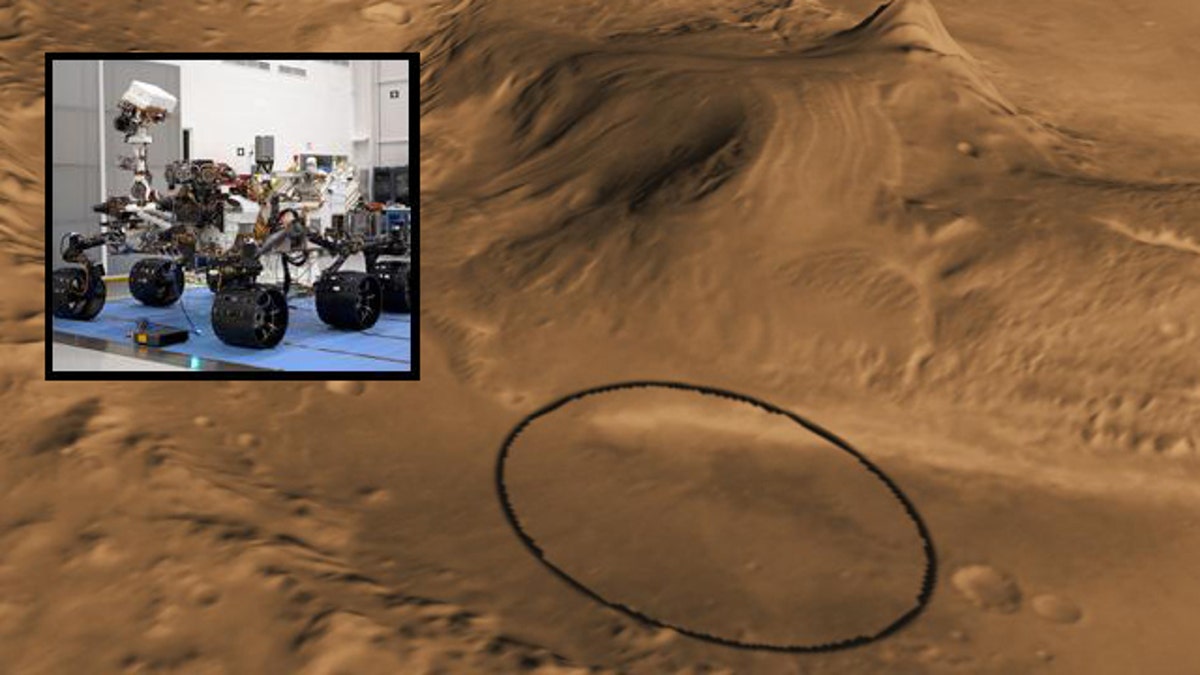
This computer-generated view shows Mars' Gale crater (circled), which NASA has selected as the landing site for the next Mars rover (inset), due to hit the planet in August 2012. (NASA/JPL-Caltech/ASU/UA)
Next stop, Gale Crater.
NASA has chosen the landing spot for the car-sized Mars Science Laboratory, the successor to the famously successful Spirit and Opportunity rovers and the next visitor to the Red Planet.
The Mars Science Laboratory, or Curiosity, is scheduled to launch late this year and land in August 2012. The target crater selected on Friday spans 96 miles and holds a mountain rising higher from the crater floor than Mount Rainier rises above Seattle. Gale Crater is about the combined area of Connecticut and Rhode Island.
"Mars is firmly in our sights," said NASA Administrator Charles Bolden. "Curiosity not only will return a wealth of important science data, but it will serve as a precursor mission for human exploration to the Red Planet."
NASA looked at several sites and assessed their safety thanks to the HiRISE camera, a high-resolution imager mounted in a satellite orbiting Mars. HiRISE is pointed at the Red Planet and allowed NASA to study in ultrahigh resolution the various points that might merit the best landing zones. There were about 30 potential sites that over 100 scientists began studying in 2006; in 2008, the group whittled the list down to four candidate spots.
"Scientists identified Gale as their top choice to pursue the ambitious goals of this new rover mission," said Jim Green, director for the Planetary Science Division at NASA Headquarters in Washington. "The site offers a visually dramatic landscape and also great potential for significant science findings."
"One fascination with Gale is that it's a huge crater sitting in a very low-elevation position on Mars, and we all know that water runs downhill," said John Grotzinger, the mission's project scientist at the California Institute of Technology in Pasadena, Calif. "Gale offers attractions similar to Mars' famous Valles Marineris, the largest canyon in the solar system."
Curiosity is about twice as long and more than five times as heavy as any previous Mars rover. Its 10 science instruments include two for ingesting and analyzing samples of powdered rock that the rover's robotic arm collects. A radioisotope power source will provide heat and electric power to the rover.
NASA has tweaked the methodology for delivering the new craft to the Martian surface, the space agency said. This time around, a rocket-powered sky crane suspending Curiosity on tethers will lower the rover directly to the Martian surface.
The new mission isn't merely a "follow-the-water" expedition, as previous trips to Mars have been. The rover's science payload can identify other ingredients of life, NASA said, such as the carbon-based building blocks of biology called organic compounds.
Is NASA hoping the new rover will find evidence life on Mars?
"Gale gives us attractive possibilities for finding organics, but that is still a long shot," said Michael Meyer, lead scientist for NASA's Mars Exploration Program at agency headquarters. "What adds to Gale's appeal is that, organics or not, the site holds a diversity of features and layers for investigating changing environmental conditions, some of which could inform a broader understanding of habitability on ancient Mars."
Nevertheless, the mission isn't necessarily a go. NASA faces the same issues many households today do: budgetary woes.
The space agency's auditors announced in June that, already overbudget and behind schedule, the next rover may need more money to meet its launch date. The price tag has ballooned to $2.5 billion from $1.6 billion.
NASA's internal watchdog faulted project managers for routinely underestimating costs and calculated that an extra $44 million may be needed to avoid another delay or cancellation.
The rover and other spacecraft components are being assembled and undergoing final testing. The mission is targeted to launch from Cape Canaveral Air Force Station in Florida this fall, sometime between Nov. 25 and Dec. 18.
